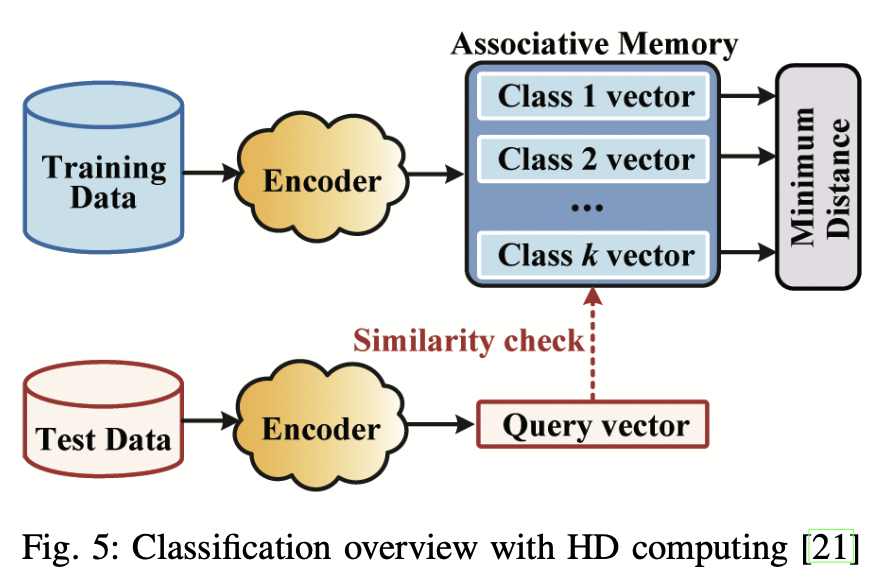Classification using Hyperdimensional Computing: A Review
2024-02-16
Keywords: #HDC
0. Abstract
- hypervectors: Unique data type for HD computing
1. Introduction
- HD computing represents different types of data using hypervectors, whose dimensionality is in the thousands (e.g. 10,000-$d$)
- Hypervectors are composed of IID components (binary, integer, real or complex)
- ✪ The concept of orthogonality
2. Background on HD Computing
A. Classical Computing vs HD Computing
- Three key factors of computing: 1) Data representation, 2) data transformation, and 3) data retrieval
- Data representation: Hypervector
- Data transformation: Add-Multiply-Permute
- Data retrieval: ?
- class hypervector: hvs generated from training data
- query hypervector: hvs generated from the test data

B. Data Representation
- Divided into two categories: binary or non-binary (bipolar, integer)
- Non-binary hv: More hardware-friendly
- Binary hv: Higher accuracy
C. Similarity Measurement
- Non-binary hv: cosine similarity
- Only depend on orientation, focusing on the angle and ignoring the impact of magnitude.
- Binary hv: normalized Hamming distance
- Orthogonality in high dimensions: Randomly generated hypervectors are nearly orthogonal to each other when $d$ is high.
- Orthogonal hvs = dissimilar: Operations performed on theses orthogonal hvs can form associations or relations.

D. Data Transformation
1. Bundling
- Pointwise addition
- Majority Rule
2. Binding
- Pointwise multiplication = XOR operation
- Aims to form associations between two related hypervectors
- $X = A \oplus B$ becomes otrthogonal to both $A$ and $B$
3. Permutation
- Circular right bit-shift
- $\text{Ham}(\rho (A), A) \sim 0.5$ for ultra-wide hvs
3. The HD Classification Methodology
A. The HD Classification Methodology
- The encoder employs randomly generated hvs to map training data to HD space.
- A total of $k$ class hypervectors are trained and stored in the associative memory.
- Inference phase: the encoder generates the query hv for each test data
- Similarity check between the query hv and class hv in the associative memory.
- The label with the closest distance is returned.

B. Encoding Methods for HD Computing
- Encoding: Mapping input data into hvs, somewhat similar to extraction of features
- Record-based Encoding
- Position hvs: Randomly generated to encode the feature position information → Orthogonal to each other
- Level hvs: The feature value information is quantized to $m$ level hvs. For an $N$-dim feature, a total of $N$ level hvs should be generated, which are chosen from the $m$ level hvs. → Randomly bit-flip $d/m$ ($d$ is dimension) to generate next level hv, the last-level hv being nearly orthogonal to the first hv.
- Encoding: Bind each position hv with its level hv. The final encoding hv $\mathbf{H}$ is obtained by bundling.
- N-gram-based encoding
- Random level hvs are generated, then feature values are obtained by permuting these level hvs.
- (ex) the level hv $\bar{\mathbf{L}_i}$ corresponding to the $i$-th feature position is rotationally permuted by $(i-1)$ positions.
- The final encoded hypervector $\mathbf{H}$ is obtained by binding each permuted level hvs.
- Kernel encoding ✪
C. Benchmarking Metrics in HD Computing
- Tradeoff between accuracy and efficiency.
- Accuracy: Appropriate choice of encoding method, and retraining iteratively (compared to single-pass training) improves the training accuracy.
- Efficiency
- Algorithm: Dimension reduction
- Hardware: Binarization (employing binary hvs instead of non-binary model), Quantization, Sparsity → HW acceleration anticipated combining HD computing with in-memory computing